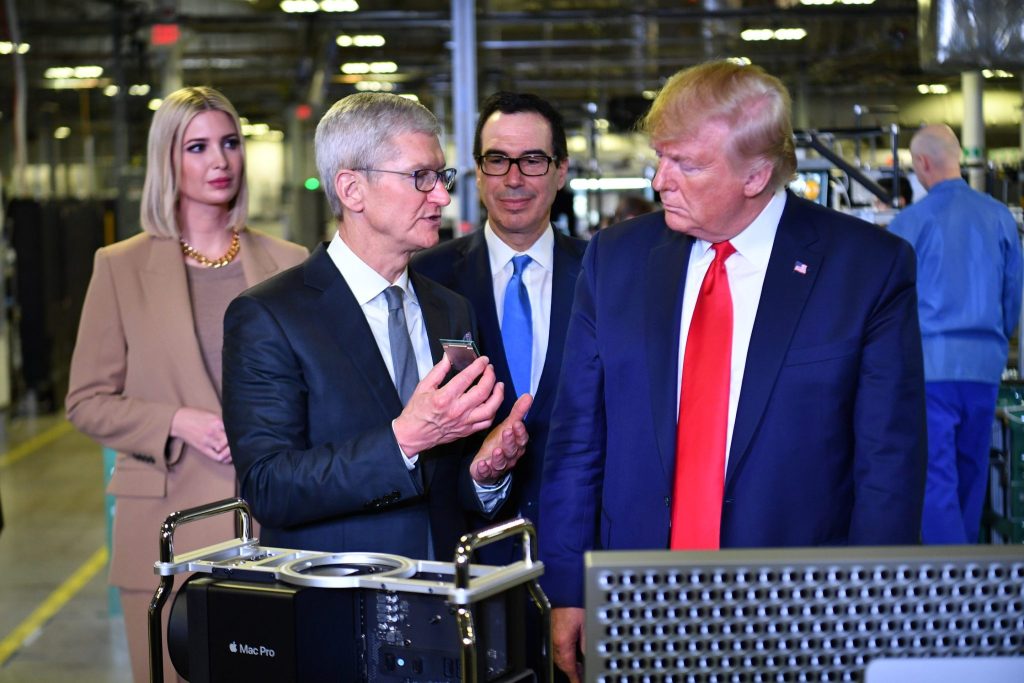- President Donald Trump said he told Apple CEO Tim Cook he was not happy about the tech company’s investment in manufacturing in India. Trump is likely pressuring Cook to increase U.S. production, according to Morningstar analyst William Kerwin, despite it not being practical or cost-effective. The president and CEO have a history of diplomacy and compromise.
President Donald Trump’s insistence on Apple stopping production in India is part of the president’s plan to “squeeze” more investments in U.S. manufacturing out of the tech giant, one analyst says. Trump’s request is the latest in a yearslong push-and-pull between him and Apple CEO Tim Cook.
Trump said on Thursday he told Cook to stop production in India, months after the tech giant reportedly made plans to accelerate production in the country. Apple has made the strategic shift to India amid Trump’s steep tariffs in China, where Apple has 80% of its production capacity and where 90% of iPhones are assembled, according to Evercore ISI.
“I had a little problem with Tim Cook yesterday,” Trump said, referring to a state visit he made to Qatar. “I said to him, ‘my friend, I treated you very good. You’re coming here with $500 billion, but now I hear you’re building all over India.’ I don’t want you building in India.”
“We’re not interested in you building in India. India can take care of themselves…we want you to build here,’” he added.
Apple announced in February plans to invest $500 billion in U.S. manufacturing over the next four years, hiring 20,000 new workers and building a Texas plant to produce servers. But the tech giant is reportedly also intending to build and import most of its iPhones for U.S. customers in India by 2026 in order to dodge tariffs. Apple currently assembles 40 million iPhones in India; the goal would be to more than double its output in the country by next year.
Beyond wanting to dodge geopolitical tensions, Apple’s investment in manufacturing in India allows it to continue to keep labor costs low, as they are in China. Though Apple has established a large skilled workforce in China, its decision to build products in India has been buoyed by its large consumer base there, as well as manufacturing subsidies by the government to incentivize moves away from China.
Trump will want to see a bigger commitment to U.S. production beyond what is promised in the $500 billion investment, according to William Kerwin, a senior technology analyst at Morningstar. The president’s ultimate goal will likely be getting America’s largest tech company to commit to a “full-blown manufacturing facility” for iPhones or auxiliary Apple products, he said.
“It’s a little bit of a game of chicken,” Kerwin told Fortune. “Tim Cook, I think, has done a very good job of doing corporate diplomacy with the Trump administration, both in the first administration and the current one. But I think at the end of the day, Trump knows how debilitating a significant, full impact of tariffs would be on Apple and the business.”
Indeed, Cook warned earlier this month that Trump’s tariffs on China—then at 145%—would cost Apple an extra $900 million in the quarter beginning in June. Trump met with Cook earlier this week amid a report Apple will consider raising iPhone prices. Though a trade deal with China lowered these tariffs to 30%, Kerwin argued the steep levies give Trump some leverage.
“It’s just saying, ‘I think we can squeeze a little bit more out of you,’” Kerwin said.
Apple did not respond to Fortune’s request for comment.
A history of ‘corporate diplomacy’
Trump’s comments on Cook are hardly the first time the president and the Apple CEO have made requests of each other and tested their yearslong relationship.
Despite Trump accidentally calling the CEO “Tim Apple” at a 2019 American Workforce Policy Advisory Board meeting, the two have maintained a copacetic relationship, a strategy to establish more favorite political outcomes for both parties. At the crux of their relationship, from Apple’s perspective, is to maintain low iPhone prices, while making concessions to source some parts, such as its glass phone screens, from U.S. manufacturers.
“It is giving up some inches to avoid giving up the mile,” Kerwin said.
This strategy took hold early in Trump’s first presidency. When Trump was developing his tax-cut plan in 2017, Cook told him Apple would increase spending in the U.S. if the company was permitted to bring back $250 billion in overseas cash at a lower tax rate, the Wall Street Journal reported in 2019.
The concessions are bidirectional. In 2019, when Trump first proposed steep taxes on Chinese exports, Apple successfully lobbied the administration to exempt a category of high-tech products, which would include Apple Watches and AirPods, from the tariffs.
Cook shouldn’t have to adjust his previous playbook in managing Trump’s request regarding India manufacturing, particularly because it’s not in Trump’s best interest to have iPhone prices double under his administration, Kerwin posited. If consumers were to link higher iPhone prices with Trump’s policy, it would dredge up negative sentiment about the economy and his presidency. Instead, Cook will likely not entirely acquiesce, but could make another pledge to increase Apple’s U.S. investment.
“It’s going to be somewhere in between, just to make both sides happy and to have some sort of headline announcement, even If it doesn’t move the needle all that much,” Kerwin said.
This story was originally featured on Fortune.com





